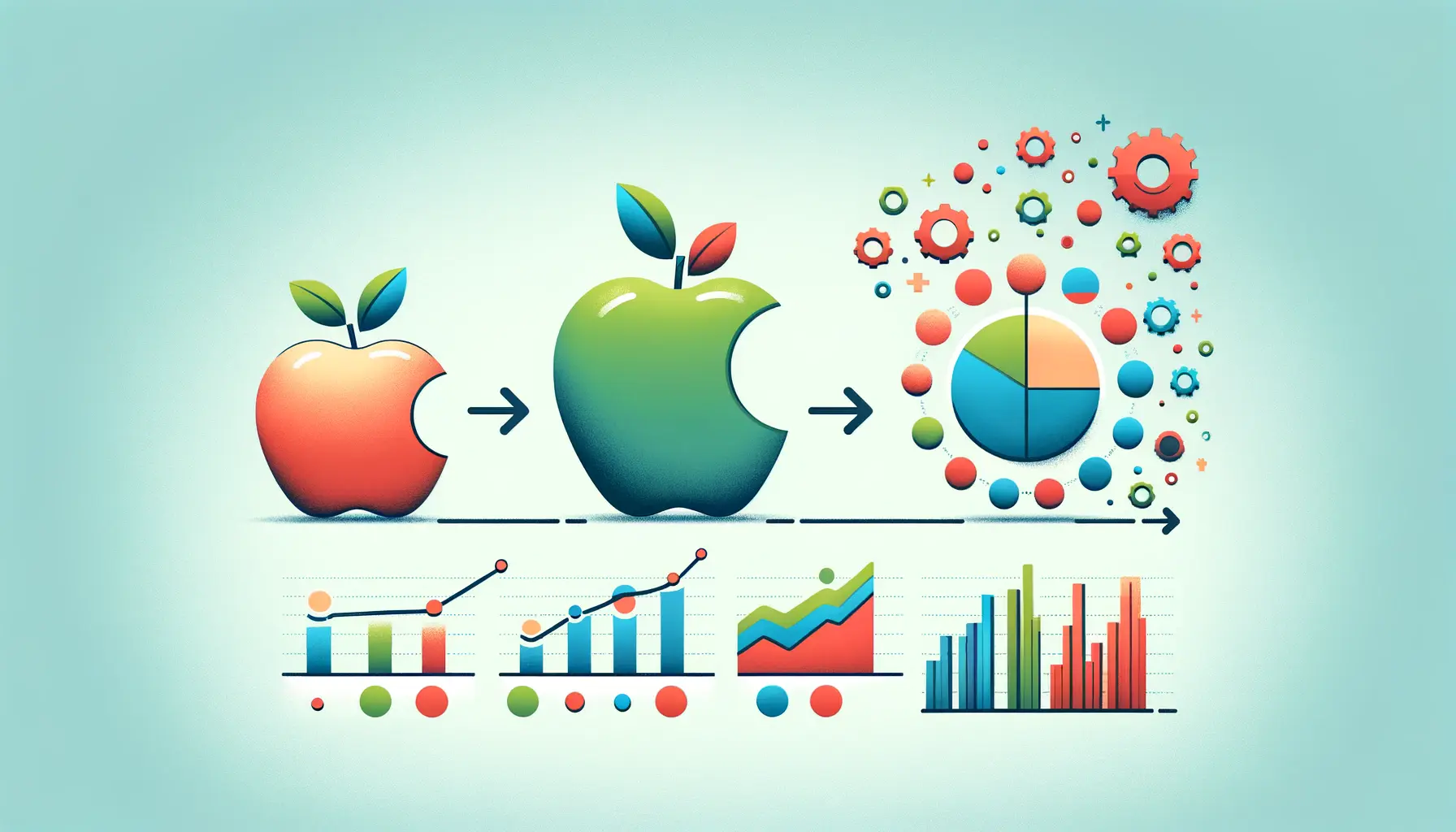In the rapidly evolving tech landscape, Apple’s strategic moves are always under the microscope, with industry insiders and consumers alike keen to understand the direction one of the world’s leading tech giants is heading.
As we edge closer to 2024, Apple measurement strategy, particularly in the realm of Apple Search Ads Measurement, has garnered significant attention.
This strategy is not just a testament to Apple’s innovative approach but also a reflection of its commitment to enhancing user experience and privacy while ensuring advertisers can effectively reach their target audience.
Apple’s measurement strategy for 2024 is poised to redefine the dynamics of digital advertising and app measurement.
With a keen focus on privacy and data protection, Apple is setting new standards that prioritize user consent and data minimization.
This approach is not only in response to growing regulatory pressures but also aligns with Apple’s longstanding commitment to user privacy.
By leveraging advanced technologies and methodologies, Apple aims to provide advertisers with valuable insights into their campaigns’ performance without compromising user privacy.
- Understanding Apple’s Measurement Ecosystem
- Privacy and Data Protection: Core Pillars of Apple’s Strategy
- Innovations in Measurement and Analytics
- Challenges and Opportunities in Apple’s Measurement Approach
- Strategies for Success in Apple’s Evolving Ecosystem
- Future Trends in Apple’s Measurement Ecosystem
- Maximizing ROI in Apple’s Measurement Framework
- Conclusion: Navigating Apple’s Measurement Strategy for 2024
- FAQs on Apple Measurement Strategy for 2024
Understanding Apple’s Measurement Ecosystem
At the heart of Apple’s measurement strategy lies its sophisticated ecosystem, designed to offer a seamless and integrated experience for both developers and advertisers.
This ecosystem is built around the Apple Search Ads platform, which allows for precise targeting and measurement of ad campaigns within the App Store.
Apple’s approach to measurement is multifaceted, incorporating a blend of first-party data, anonymized data sets, and advanced algorithms to ensure accurate and meaningful insights into user behavior and ad performance.
One of the key components of Apple’s strategy is the SKAdNetwork, which provides a privacy-friendly way to measure ad conversions without revealing any identifiable information about the user.
This framework is indicative of Apple’s broader strategy to balance effective measurement with privacy considerations.
By anonymizing and aggregating data, Apple ensures that advertisers can optimize their campaigns based on performance metrics while adhering to the highest standards of user privacy.
Advancements in Apple Search Ads Measurement
Apple Search Ads has become an indispensable tool for developers looking to promote their apps within the App Store.
With the introduction of new features and capabilities, Apple is enhancing the platform’s effectiveness as a measurement tool.
These advancements include more granular targeting options, improved attribution models, and enhanced reporting features that offer deeper insights into campaign performance.
By continuously refining the Apple Search Ads platform, Apple is empowering advertisers to make data-driven decisions that drive app discovery and engagement.
Moreover, Apple’s commitment to transparency and control is evident in the way it handles ad measurement.
Advertisers have access to a wealth of data that allows them to understand how users interact with their ads, including conversion rates, engagement metrics, and more.
This level of detail enables advertisers to fine-tune their strategies for maximum impact.
Additionally, Apple provides users with the ability to control their ad preferences, further reinforcing its stance on privacy and user empowerment.
Apple’s measurement strategy for 2024 is a sophisticated blend of privacy, innovation, and user-centricity, setting new benchmarks for the digital advertising industry.
Privacy and Data Protection: Core Pillars of Apple’s Strategy
Privacy and data protection stand at the forefront of Apple’s measurement strategy, reflecting the company’s unwavering commitment to safeguarding user information.
In an era where data breaches and privacy concerns are rampant, Apple’s proactive stance on privacy is not only commendable but sets a benchmark for the industry.
This commitment is manifested through several key initiatives and technological advancements designed to enhance privacy while still delivering valuable insights to advertisers.
Apple’s approach to privacy is holistic, encompassing various aspects of user data handling and processing.
By implementing stringent data protection measures, Apple ensures that user information is secure and used responsibly.
This approach is rooted in the principle of data minimization, where only the necessary amount of data is collected, and user anonymity is preserved.
Key Privacy Features in Apple’s Measurement Strategy
- App Tracking Transparency (ATT): A framework that requires apps to obtain user consent before tracking their activity across other apps and websites. This feature empowers users to control their data and decide whether they want to be tracked for advertising purposes.
- SKAdNetwork: An API that allows advertisers to measure the success of their ad campaigns without compromising user privacy. It provides aggregated and anonymized data, ensuring that individual user information remains private.
- Limited Ad Tracking (LAT): A setting that users can enable to restrict the amount of data that advertisers can collect about them. This feature is part of Apple’s broader efforts to give users more control over their personal information.
These features are indicative of Apple’s proactive approach to privacy, ensuring that users have the final say in how their data is used.
By integrating these privacy features into its measurement strategy, Apple not only adheres to regulatory requirements but also aligns with consumer expectations for privacy and data protection.
Impact on Advertisers and Developers
The emphasis on privacy and data protection has significant implications for advertisers and developers.
While these measures ensure user trust and compliance with privacy regulations, they also require advertisers to adapt their strategies.
Advertisers must now rely on less granular data and focus on aggregated and anonymized metrics to gauge their campaigns’ effectiveness.
This shift challenges traditional advertising models but also opens up opportunities for innovation in ad targeting and measurement.
Developers, on the other hand, benefit from a trusted platform that respects user privacy while still offering tools to promote their apps effectively.
Apple’s privacy-centric approach encourages developers to build apps that prioritize user consent and data protection, fostering a healthier app ecosystem.
Embracing privacy and data protection as core pillars of its measurement strategy, Apple is navigating the delicate balance between effective advertising and user privacy rights.
Innovations in Measurement and Analytics
Apple’s measurement strategy for 2024 is not only about enhancing privacy but also about pushing the boundaries of what’s possible in measurement and analytics.
Through continuous innovation, Apple aims to provide advertisers and developers with advanced tools and technologies that offer deeper insights into user behavior and ad performance, all while maintaining a strong commitment to user privacy.
These innovations are part of Apple’s broader efforts to create a more transparent, effective, and user-friendly advertising ecosystem.
By leveraging the latest technologies, Apple is able to offer a unique blend of accuracy, privacy, and functionality in its measurement solutions.
Advanced Analytics with Apple Search Ads
- Conversion Value Management: This feature allows advertisers to assign different values to various conversion types, enabling a more nuanced understanding of user actions post-ad interaction. It helps in optimizing ad campaigns for higher-value conversions.
- Creative Sets Optimization: Advertisers can test different ad creatives and see which ones perform best in terms of user engagement and conversion. This tool leverages machine learning to automatically adjust ad displays based on performance.
- Keyword-Level Attribution: By providing detailed insights into which keywords are driving app downloads and engagements, Apple Search Ads enables advertisers to fine-tune their keyword strategies for better targeting and higher ROI.
These advanced analytics capabilities are designed to give advertisers a competitive edge by enabling more strategic decision-making and campaign optimization.
By understanding user behavior and preferences at a deeper level, advertisers can create more effective and personalized ad experiences.
Leveraging Machine Learning for Enhanced Measurement
Machine learning plays a pivotal role in Apple’s measurement strategy, powering many of the advanced features and capabilities of Apple Search Ads.
By analyzing vast amounts of data, machine learning algorithms can identify patterns and trends that human analysts might miss.
This allows for more accurate predictions and insights, which in turn can lead to more effective ad campaigns.
Moreover, machine learning enhances the efficiency of ad targeting and measurement by automating complex processes and dynamically adjusting strategies based on real-time data.
This not only saves time and resources but also improves the overall performance of ad campaigns.
Apple’s innovations in measurement and analytics, particularly through the use of advanced analytics and machine learning, are setting new standards for what’s possible in digital advertising, all while upholding the company’s commitment to privacy.
Challenges and Opportunities in Apple’s Measurement Approach
While Apple’s measurement strategy for 2024 is poised to transform the digital advertising landscape, it also presents a unique set of challenges and opportunities for advertisers, developers, and the broader industry.
Navigating these challenges requires a deep understanding of Apple’s ecosystem and a willingness to adapt to its evolving privacy-centric approach.
However, within these challenges lie significant opportunities for innovation and growth.
By aligning with Apple’s commitment to privacy and user-centric measurement, advertisers and developers can foster stronger relationships with their audiences and build trust that is increasingly becoming a competitive advantage in the digital age.
Adapting to a Privacy-First World
- Challenge: The increasing emphasis on privacy, particularly with features like App Tracking Transparency, limits the amount of user data available for targeting and measurement. This can make it more difficult for advertisers to deliver personalized ads and measure their effectiveness accurately.
- Opportunity: This shift encourages advertisers to explore new strategies for engaging users, such as focusing on contextually relevant ads and leveraging first-party data. It also pushes the industry towards more privacy-friendly measurement solutions that can provide valuable insights without compromising user privacy.
Embracing New Measurement Technologies
- Challenge: Keeping up with Apple’s innovations in measurement and analytics requires advertisers and developers to continuously update their skills and tools. This can be resource-intensive and may pose a barrier to smaller players.
- Opportunity: The adoption of advanced measurement technologies, such as machine learning and conversion value management, opens up new avenues for optimizing ad campaigns and understanding user behavior. It also levels the playing field by providing all advertisers access to sophisticated analytics tools.
Building Trust Through Transparency
- Challenge: The demand for greater transparency in how user data is collected and used can be challenging for advertisers accustomed to more opaque measurement practices.
- Opportunity: By prioritizing transparency and user consent, advertisers can build trust with their audience. This trust, in turn, can lead to higher engagement rates and a more loyal user base. Furthermore, transparency in measurement practices can help advertisers and developers better comply with regulatory requirements.
Despite the challenges posed by Apple’s privacy-centric measurement strategy, the opportunities for innovation, user engagement, and trust-building are immense. Advertisers and developers who embrace these changes can thrive in the evolving digital advertising ecosystem.
Strategies for Success in Apple’s Evolving Ecosystem
As Apple continues to refine its measurement strategy, advertisers and developers must adapt to thrive within this evolving ecosystem.
Success in this environment requires a strategic approach that balances effective advertising with respect for user privacy.
Here, we explore key strategies that can help navigate Apple’s ecosystem successfully, ensuring that your advertising efforts are both effective and compliant with Apple’s privacy standards.
Implementing these strategies not only aligns with Apple’s measurement approach but also positions advertisers and developers to capitalize on the opportunities presented by Apple’s focus on privacy and user-centric advertising.
Optimize for App Tracking Transparency (ATT)
- Understand ATT Framework: Familiarize yourself with how the ATT framework impacts ad targeting and measurement. Understanding the nuances of user consent can help you better navigate the limitations and opportunities it presents.
- Focus on Value Proposition: To encourage users to opt-in for tracking, clearly communicate the value they will receive in return, such as personalized content or a better app experience. Transparency about data usage can also increase user trust and opt-in rates.
Leverage SKAdNetwork for Attribution
- Adapt to SKAdNetwork’s Limitations: While SKAdNetwork offers a privacy-friendly way to measure ad conversions, it also comes with limitations, such as delayed reporting and lack of granular data. Develop strategies to work within these constraints while still gaining valuable insights.
- Utilize Conversion Value Mapping: Make the most of SKAdNetwork’s conversion value mapping feature to understand user behavior and optimize your campaigns accordingly. This requires a strategic approach to assigning values to different user actions.
Embrace First-Party Data and Contextual Advertising
- Invest in First-Party Data: With third-party cookies phasing out and Apple’s strict privacy measures, first-party data becomes invaluable. Focus on building your own data repositories through user interactions and engagements within your app or website.
- Explore Contextual Advertising: Contextual advertising, which targets ads based on the content of the website or app where they appear, can be an effective alternative to personalized advertising in a privacy-first world. It allows for relevant ad placements without relying on user tracking.
Adapting to Apple’s measurement strategy requires a proactive and strategic approach, focusing on privacy, transparency, and leveraging the tools and frameworks provided by Apple. By doing so, advertisers and developers can achieve success while respecting user privacy and navigating the challenges of the digital advertising landscape.
Future Trends in Apple’s Measurement Ecosystem
As we look towards the future, Apple’s measurement ecosystem is expected to continue evolving, driven by technological advancements, changing consumer expectations, and regulatory pressures.
Staying ahead of these trends is crucial for advertisers and developers who wish to remain competitive and effective in their digital advertising efforts.
Here, we explore potential future trends in Apple’s measurement ecosystem and their implications for the industry.
Understanding these trends will enable advertisers and developers to anticipate changes and adapt their strategies accordingly, ensuring they remain aligned with Apple’s evolving ecosystem and continue to deliver engaging and privacy-compliant advertising experiences.
Increased Emphasis on User Privacy
- Enhanced Privacy Features: Expect Apple to introduce more sophisticated privacy features, further limiting the amount of user data available for advertising purposes. This could include more robust controls for users over their data and additional transparency requirements for apps.
- Privacy as a Competitive Advantage: As consumer awareness and concern about privacy grow, Apple’s commitment to privacy is likely to become an even more significant selling point for its devices and services, setting it apart from competitors.
Advancements in Measurement Technologies
- Machine Learning and AI: Apple is likely to further integrate machine learning and artificial intelligence into its measurement tools, offering more accurate and predictive analytics capabilities while maintaining user privacy.
- Augmented Reality (AR) in Advertising: With Apple’s continued investment in AR technologies, we may see new AR-based advertising formats that offer immersive experiences while enabling precise measurement and analytics.
Regulatory Influence on Measurement Practices
- Global Data Protection Regulations: As countries around the world introduce and update data protection laws, Apple’s measurement strategies will need to adapt to comply with these regulations, potentially leading to more uniform global privacy standards.
- Industry Collaboration: To navigate the complex regulatory landscape, Apple may seek to collaborate more closely with industry partners, regulators, and privacy advocates to develop measurement practices that balance effective advertising with privacy protection.
The future of Apple’s measurement ecosystem is poised to be shaped by a continued focus on privacy, technological innovation, and regulatory compliance. By staying informed about these trends, advertisers and developers can better prepare for the future, ensuring their strategies remain effective and aligned with Apple’s evolving ecosystem.
Maximizing ROI in Apple’s Measurement Framework
Within Apple’s evolving measurement ecosystem, maximizing return on investment (ROI) requires a nuanced understanding of the platform’s capabilities and limitations.
Advertisers and developers must navigate Apple’s privacy-centric approach while leveraging available tools and strategies to optimize their ad campaigns.
This section outlines actionable strategies for enhancing ROI within Apple’s measurement framework, ensuring that every dollar spent on advertising is used effectively.
By implementing these strategies, advertisers can improve their campaign performance, achieve better engagement with their target audience, and ultimately drive higher conversions and app installations.
Strategic Use of Apple Search Ads
- Keyword Optimization: Regularly review and refine your keyword strategy based on performance data from Apple Search Ads. Focus on high-performing keywords and consider long-tail keywords to capture more targeted traffic.
- Ad Creative Testing: Utilize Apple Search Ads’ capabilities to test different ad creatives and identify which ones resonate most with your target audience. Continuously iterate based on performance metrics to enhance ad effectiveness.
Enhancing User Experience
- Optimize App Store Presence: Ensure your app’s listing on the App Store is optimized with compelling visuals, accurate descriptions, and relevant keywords. A strong presence can improve visibility and conversion rates.
- Focus on User Retention: Implement strategies to retain users who install your app, such as personalized onboarding experiences, regular updates with new features, and engaging in-app content. Higher retention rates can lead to better ROI in the long term.
Data-Driven Decision Making
- Leverage Analytics Tools: Make full use of Apple’s analytics tools and third-party solutions that comply with Apple’s privacy guidelines to gain insights into user behavior and campaign performance.
- Iterative Campaign Management: Adopt an iterative approach to campaign management, where you continuously analyze performance data, make informed adjustments, and test new strategies to improve ROI.
Adapting to Privacy Regulations
- Stay Informed: Keep abreast of changes in privacy regulations and Apple’s policies to ensure your advertising practices remain compliant and effective.
- Privacy-Friendly Targeting: Explore alternative targeting strategies that respect user privacy, such as contextual targeting, to maintain campaign effectiveness without relying on personal data.
Maximizing ROI in Apple’s measurement framework requires a balance between strategic advertising, enhancing user experience, making data-driven decisions, and adapting to privacy regulations. By focusing on these areas, advertisers can navigate Apple’s ecosystem successfully and achieve their marketing objectives.
Conclusion: Navigating Apple’s Measurement Strategy for 2024
As we have explored throughout this article, Apple’s measurement strategy for 2024 is a comprehensive approach that balances the need for precise advertising measurement with an unwavering commitment to user privacy.
This strategy reflects Apple’s broader vision for a digital ecosystem where user experience and privacy are paramount, setting new standards for the advertising industry.
Advertisers and developers navigating this ecosystem must adapt to these changes, leveraging Apple’s tools and adhering to its privacy guidelines to achieve success.
Key Takeaways for Advertisers and Developers
To thrive within Apple’s evolving measurement framework, several key strategies emerge:
- Embrace privacy-centric advertising practices, aligning with Apple’s App Tracking Transparency and SKAdNetwork guidelines.
- Optimize ad campaigns using Apple Search Ads’ advanced analytics and machine learning capabilities for targeted and effective advertising.
- Invest in first-party data and contextual advertising to navigate the limitations on user data access while still engaging meaningfully with target audiences.
- Stay agile and informed about the latest trends and regulations affecting digital advertising to ensure compliance and maximize ROI.
By focusing on these strategies, advertisers and developers can not only comply with Apple’s measurement strategy but also unlock new opportunities for engagement and growth in a privacy-first digital landscape.
Looking Ahead: The Future of Digital Advertising with Apple
The future of digital advertising in Apple’s ecosystem is poised for significant evolution.
As technology advances and consumer expectations around privacy continue to rise, Apple’s measurement strategy will likely continue to adapt.
For advertisers and developers, staying ahead of these changes will be crucial.
Success will depend on their ability to innovate within the constraints of privacy regulations, leveraging new tools and technologies to connect with users in meaningful ways.
In conclusion, Apple’s measurement strategy for 2024 offers both challenges and opportunities for the digital advertising industry.
By prioritizing user privacy and data protection while providing robust tools for measurement and analytics, Apple is charting a course towards a more transparent, user-friendly digital advertising future.
For advertisers and developers willing to embrace this vision, the potential for creating engaging, effective, and privacy-compliant advertising experiences is immense.
If you're seeking expertise in Apple Search Ads campaigns, visit our service page for professional management!
FAQs on Apple Measurement Strategy for 2024
Explore commonly asked questions about Apple’s measurement strategy as we move towards 2024, focusing on how these strategies impact both users and advertisers within the Apple ecosystem.
Apple’s 2024 measurement strategy emphasizes user privacy while providing advertisers accurate analytics through anonymized and aggregated data, leveraging technologies like SKAdNetwork and App Tracking Transparency.
App Tracking Transparency requires user consent before tracking their activity, challenging advertisers to adapt their strategies to focus on privacy-friendly methods of engaging users.
SKAdNetwork allows for the measurement of ad campaign effectiveness without compromising user privacy, providing advertisers with aggregated, anonymized data on user conversions.
Yes, but with limitations. Advertisers must rely more on contextual advertising and first-party data, ensuring personalization aligns with Apple’s privacy guidelines.
Developers must optimize app engagement and retention strategies within privacy constraints, focusing on creating valuable user experiences to encourage voluntary data sharing.
Apple Search Ads offer precise targeting within the App Store, enabling advertisers to reach potential users at the point of search with high intent, improving conversion rates.
By leveraging Apple’s analytics and SKAdNetwork’s conversion value mapping, advertisers can optimize campaigns for higher-value user actions, enhancing overall ROI.
Expect continued innovation in privacy-preserving measurement technologies, increased use of machine learning for analytics, and further integration of AR in advertising strategies.














